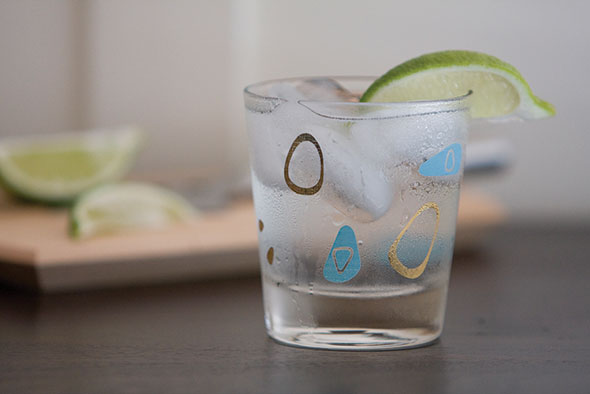
Photography by Aaron Campbell
For many people there is no middle ground with gin. They either love it, or hate it. But for a beverage that elicits such strong, singular opinions, its proponents couldn’t be more diverse. Among those who favor gin are members of British Parliament and house partiers in Compton. Gin passed muster with the notoriously discerning taste of Prime Minister Winston Churchill and carried enough street-cred to be mentioned repeatedly on Snoop Dogg’s now classic debut album.
At the same time, detractors have called gin everything from “old lady’s bathwater” to “florist’s piss.” And those are the printable comments.
So how can a drink that carries clout among high brows and urban bad asses alike get such a bad rap?
The fall of gin’s reputation is historically, and paradoxically, linked to its popularity.
The libation was first introduced to British life in the seventeenth century when England’s military joined forces with the Dutch to battle Spain. The soldiers found that Holland’s juniper-flavored drink raised their ardor, and when they returned across the Channel, they took its recipe with them. Gin then got a royal boost during the late seventeenth century when William III encouraged his subjects to drink it instead of the cider they were fond of. The monarch hoped his decree would discourage the British from drinking imports from countries that retained ties to the Catholic Church.
Apparently, the people took the king’s message hook, line and tankard. Within 50 years of his ascent to the throne, gin drinking was so prevalent it became problematic. Parliament feared it would cause society’s collapse. In an attempt to curb consumption and restore order, several Gin Acts were passed between 1729 and 1751. Commoners responded the way people deprived of their favorite drink have done for centuries. They established bootleg stills.
Gin’s pretty easy to make. Unlike whiskey or wine, it can be brewed without aging or barrels. All that’s needed is a basin big enough to hold the fermenting alcohol and some herbs to infuse it with flavor.
In eighteenth century England, bootleggers used their washbasins for gin production. Later, during the U.S. Prohibition of the twentieth century, bathtubs were used giving rise to the “bathwater” nickname. The flowers, herbs and spices masked the gin’s harsh flavor providing more fuel for the insults; or to some drinkers’ palates, insult to injury.
Gin’s popularity as a quick, cheap hit of choice grew. Public intake reached dangerous proportions, causing “misery and even death,” across England in the eighteenth century according to food historian James Trager. An etching from the era depicts an infant falling from his mother’s breast. The despondent woman is too tanked to notice, let alone care.
Eventually the government tried to control public drunkenness by regulating the market. The repeal of the Gin Acts allowed for the creation of reputable distilling houses like Booth’s and Gordon’s.
Beefeater appeared in England in the early nineteenth century, its trademark guardsman is a nod to the gentlemanly ways of the British military. Apparently serving a good gin drink was not only good manners, it was duty.
Gin’s origins as a drink of the people may be what earned it mention in Snoop Dogg’s videos, but it was the later tie to upscale behavior and its use in history’s classiest cocktails—Tom Collins’, Gimlets, and of course, the original Martini—that keeps it on bar menus today.
TEXT BY Steven Gdula

Ask gin drinkers to name their favorite brand, and the reasons for their loyalty to that label can be as varied as the ingredients in the bottle. Like wine, gin takes well to the subtle notes imparted by additional ingredients. Below we’ve assembled a list of some stalwarts and newcomers along with the elements that make each one so special.
Boodles
For many drinkers this is the British gin of choice, and they’re in good company: Winston Churchill allegedly found its charms undeniable. Named for an old London men’s club, Boodles gets its distinctive flavor from the coriander seeds added to the juniper-berry base. The earthy coriander adds an extra note of dryness and turns a Martini made with Boodles into the perfect pre-dinner cocktail.
Seagram’s Extra Dry
One of the few gins that gets named-checked by rappers and is aged in oak. Its citrus notes are high allowing it to blend well with a variety of juices. Some drinkers swear it’s the infusion of cinnamon that gives Seagram’s Extra Dry Gin a little extra bite, while others find it makes it too medicinal.
Bombay Sapphire
Known as much for its blue bottle and ad campaign, Bombay Sapphire has built its exclusivity on a recipe that includes nearly a dozen botanicals. Alongside the coriander the skilled taster will recognize hints of lemon, licorice and almonds.
Beefeater
Old school? Maybe, but it is the world’s most exported gin. Sometimes old masters are the best teachers.
Gordon’s
Another old master, and the world’s top seller. The hint of mint and licorice help Gordon’s retain its
dry edge while a bit of fruit essence keeps the
balance right.
Tanqueray No. Ten
Upping the “specialty drink” ante, Tanqueray’s No. Ten is the established label’s elite pour. Raising it above the other gins on the market is the high bright note it gets from lime. The infusion of chamomile also makes for a soothing finish.
Plymouth
We’re giving it some ink simply because it’s one of the oldest surviving gin distilleries around. Established in the late eighteenth century Plymouth’s distillers recipe has changed little.
Graffiti Gin
Like its British counterparts, this Scottish gin is distilled in copper pots. And like another favorite British beverage, Pimm’s, Graffiti Gin’s recipe is closely guarded. If a good mystery appeals to you, a Martini made with Graffiti should keep you guessing.

